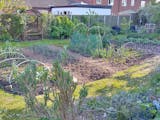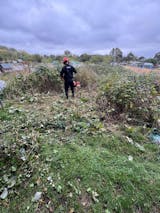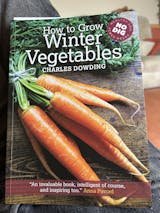Advice for starting no dig
I give a brief outline of no dig, and explain how to get started. We have created a pdf of this information so that you can download it for easy reference.
Also check out my online course, No Dig Growing for Beginners!
What is no dig
No dig means two things.
First, leave soil undisturbed as much as is practical. You may occasionally need to use a spade or trowel, for example when cutting out bramble roots, making a hole for planting trees, or planting seed potatoes.
The second part of no dig is to feed the masses of soil life, with organic matter on the surface. This is how it happens in nature, where old leaves and woody materials are always decaying on top of the ground.
For growing annual plants such as most vegetables, especially in damp climates, I recommend using compost as the surface mulch, rather than undecomposed materials. This speeds up the increase in fertility needed by vegetables, and reduces habitat for slugs.
Why use no dig
No dig makes life easier for us and allows soil life to flourish out of sight, and plants grow more healthily. Both moisture retention and drainage are improved, there are fewer weeds to hoe or remove, and you don’t get muddy boots!
My advice takes the mystery out of gardening, to make it timesaving, straightforward and enjoyable. I receive many comments like this:
We’re just now entering year two of no dig and it certainly is very enjoyable compared to past years of endless weeding and bed preparation. TurbineBorescope, YouTube Subscriber
Don’t be daunted by what you may have read elsewhere or been told by others about no dig. For example, I often see claims that people cannot go no dig because they do not have, or cannot afford, enough compost.
Actually you can start with very little compost! Though if you can manage to access more, that makes it easier and increases harvests immediately, and in many subsequent years.
In addition, the results of my Two-Bed Trial are consistent over 11 years, that for the same amount of compost applied, the no dig bed gives 12% more food.
See my FAQ page for more understandings.
How to get started
1. Create a new, no dig bed
What size?
For beginners, a great option is to start small with just one bed, say 1.2 x 2.4m/4 x 8ft. Small areas concentrate your time and resources, and make management easier. Harvests are often just as plentiful as from larger areas that are less intensively cropped.
See this video of my 1.2 x 2.1m Bed by the Shed, which shows results of succession plantings all year.

Where?
You can make beds on top of any grass and weeds, which you leave in place. The mulch that will be put on top is sufficient to smother existing growth, with no digging needed.
The best place for growing vegetables is away from tall trees and hedges, for two reasons:
1. They suck a lot of moisture out of soil.
2. Shady leaves reduce light, and host pests such as slugs.
What if my soil feels too firm?
Good soil naturally feels firm, or even hard, especially when dry, and this is fine for plants to grow in. Within the firmness is an enduring structure of fine air channels and root passageways, as well as good drainage capacity.
Plants root better in dense, firm soil than in soil whose loose structure offers less support to their stems.
Plus since 2014, my Three-Strip Trial has shown an 8% reduction in harvests from the strip where soil is forked to loosen it. I suspect this is from the mycelial network being broken.
What if my soil is clay?
No dig is a brilliant method for clay soil. At my French farm in the 1990s and at Lower Farm near Homeacres up to 2012, my soil was clay, and I found that all vegetables gave lovely harvests.

Likewise at the National Trust garden of Sissinghurst in Kent, they run a 1 acre/4000m² no dig market garden on sticky yellow clay. It is way more successful for less time needed, compared to when they were trying to cultivate the soil.
Clay soil is great for no dig: worms and other soil life improve its structure and there is good nutrient and moisture retention.
Below is Sissinghurst market garden in May 2013, soon after they changed to no dig
What if my soil is silty or stony?
At Homeacres, my soil is dense silt and everything roots into that. In my first garden, created in autumn 1982, the soil was Cotswold brash, very stony. No dig was successful there.
Undisturbed soil develops and maintains a honeycomb structure of small air passages, especially when it is fed annually with about 2.5cm/1in or so of compost on top.
What if my ground is uneven?
Uneven ground needs levelling. Either use a sharp spade to scrape off high bits and put their soil into low bits. Or buy some soil to fill the hollows. Filling them with compost is possible too, but some unevenness will remain because of the way in which compost shrinks in volume after being eaten by soil organisms.
What if my climate is different to that in the UK?
No dig works in any climate. People all over the world and in varying climates are enjoying great success with no dig – see my No Dig World Map.
Comment on YouTube from TonyJohn 2, December 2025 in Australia:
"Our climates couldn’t be more different but the composting method works wonders in our 40 degrees summers just as well as it does when we get below zero in winter."
How do I deal with weeds?
This depends on how many and which weeds you have, especially perennials, and how much organic matter you can source. All options involve laying a mulch or cover of any light-excluding material. This could be only compost, if you have enough in proportion to the vigour of existing weed growth. Other materials are cardboard underneath compost, or black plastic on top of compost.
For more information on dealing with weeds, see the weeds page of my website, my YouTube playlist and this knowledge pack.
Should my bed have wooden sides?
It’s often assumed that growing in beds means you need permanent sides, but this is untrue. It’s quicker and cheaper to create open-sided beds, and they offer fewer hiding places for slugs, ants and woodlice.
Temporary sides (such as old fence posts) help to keep compost-filled beds in shape for the first few days or months. Plus you need paths to be weed-free and with no grass, which otherwise invades beds without sides. This photo in November 2025 shows the Homeacres no-side layout.

And if you have a polytunnel, I strongly advise that you do not install wooden sides. They take up space, cost you money, and often increase the slug population. Below is December 2025, from planting six weeks earlier.

Paths without weeds are easier to achieve than often imagined, judging by my experience, and the comments I receive. And they increase the output per area from your plot because vegetables can root into the soil of pathways.
Paths are important and need you care. See my tips on how I designed Homeacres from the beginning.
How much compost will I need for making a new bed, and does it need to be a particular type?
The amount of compost needed will depend on the size of the bed (see this link for a depth calculator of compost) and also on the quantity/type of weeds.
If there are many weeds and you want to grow vegetables or flowers immediately, you will need 7-12cm/3-5in compost, firmed with your feet. If the ground is not weedy, you can start with as little as 5cm/2in compost.
The compost can have some lumps in and you do not need to sieve it. It can be any kind of decomposed material such as animal manure that has been stacked for six months or more, your own compost, municipal or mushroom compost, leaf mould, or woodchip that is over two years old.
For more information on compost, see my Compost page, and this YouTube playlist.
When is a good time to start?
You can start at any time! The sooner you start creating and planting, the sooner you’ll learn the process, and enjoy results.
How do I make a new bed?
This partly depends on existing weed growth, but the process is straightforward.
Lay a light-excluding mulch (eg cardboard) and then cover with your desired or available amount of compost. In dry conditions, it's worth watering the cardboard to soften it and help its decomposition. In damp climates, there is usually no need to water the cardboard.
If there are many vigorous perennial weeds, you can spread compost on them without any cardboard, and then black polythene (better than membrane) on top of that – see how that works in my Cover Weeds video.
You may or may not want to use temporary wooden sides to hold the compost in place. You do need to mulch any pathways around and between the new bed(s). The most common and easiest mulch for this is cardboard, held down with either a very thin layer of woody material in small pieces, or compost.
That’s it!
To watch me create a new bed using cardboard and compost, see this video, Start out no dig.




2. Start planting
With no dig, you can plant straight into compost, so a new bed is ready for planting as soon as it has been made. I advise having some plants ready in order to maximise growing time.
This applies even if there is cardboard under the compost – your new plantings can grow in the compost while the weeds die under the cardboard. Then the cardboard softens within two to three months and plants can root into the soil.
I raise the large majority of my plants in a propagating space under cover, and then transplant these into the ground. Although it requires more time than sowing directly into the ground, growth starts earlier. Also there is less pest damage, resulting in fuller beds and earlier harvests.
The two vegetables I sow directly are carrots and parsnips, because we eat their taproots which would be damaged by transplanting.
It's also good to pop in cloves of garlic, and potatoes, which can be any of medium size and not necessarily what are called ‘seed potatoes’. Potatoes are excellent as a first planting into new beds.
Do learn some basics about propagation. Having your own healthy seedlings from spring until early autumn extends the growing season and keeps your beds full.
There is a wealth of information on sowing and propagating on my YouTube channel – see this playlist. And the Sowing Timeline shows my recommendations for sowing times throughout the year.
3. Develop new skills
I recommend learning the basics of planting, spacing, weeding, watering and pest protection before moving on to skills such as harvesting methods and succession planting. My Skills for Growing book and online course cover all these, and some exciting new possibilities too.
My YouTube channel also has videos covering these topics, and I have created a playlist with a range of videos chosen specifically to help those who are new to no dig, No Dig for Beginners.
And lastly, some advice on tools and equipment. These are the ones I use the most.

When creating a new no dig bed, a wheelbarrow for transporting compost is invaluable, as is as a manure fork plus shovel for moving the compost, and a rake for levelling. See this Tools and Techniques video for further information.
For propagation, you will need potting compost (also called multipurpose), a module tray (see Recommended Products), and seeds.
The Seeds and Varieties page has my recommendations of where to source seeds, and which varieties to grow.
The compost/materials for propagation that you can buy are of variable quality. I wish you success in finding a good and local source of compost.
Sometimes compost is sold and delivered when still maturing or ripening. It then does not hold moisture, and takes nutrients from your plants. Then after 2–3 months it starts to grow decent plants, so it’s a good idea to buy compost in advance!
For transplanting, a long-handled dibber is an energy- and time-saving tool. Likewise a trowel, preferably bronze, referred to as copper. Use this for transplanting larger plants, setting seed potatoes in the ground, and levering out any regrowing roots of perennial weeds.
For watering seedlings, a 10L can with a fine rose is good, and a rose with larger holes is quicker when watering beds.
For weather and pest protection, I recommend investing in some fleece/mesh covers – see this video for more information. And Gardening Naturally for a top selection of covers.
Have fun checking my 8 Essential Tools. Your choice might be different, but the main thing is how you need fewer with no dig, and how much time you save.
I wish you every success with your growing, and hope you enjoy plentiful harvests using these no dig methods. 🌱












































